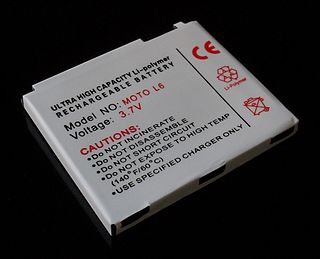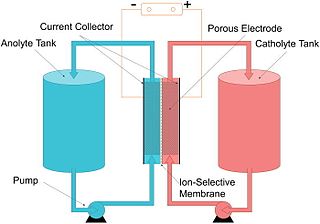
A lithium-ion or Li-ion battery is a type of rechargeable battery that uses the reversible intercalation of Li+ ions into electronically conducting solids to store energy. In comparison with other commercial rechargeable batteries, Li-ion batteries are characterized by higher specific energy, higher energy density, higher energy efficiency, a longer cycle life, and a longer calendar life. Also noteworthy is a dramatic improvement in lithium-ion battery properties after their market introduction in 1991: during the next 30 years, their volumetric energy density increased threefold while their cost dropped tenfold.

A lithium polymer battery, or more correctly, lithium-ion polymer battery, is a rechargeable battery of lithium-ion technology using a polymer electrolyte instead of a liquid electrolyte. Highly conductive semisolid (gel) polymers form this electrolyte. These batteries provide higher specific energy than other lithium battery types. They are used in applications where weight is critical, such as mobile devices, radio-controlled aircraft, and some electric vehicles.
The Innovators Under 35 is a peer-reviewed annual award and listicle published by MIT Technology Review magazine, naming the world's top 35 innovators under the age of 35.

A flow battery, or redox flow battery, is a type of electrochemical cell where chemical energy is provided by two chemical components dissolved in liquids that are pumped through the system on separate sides of a membrane. Ion transfer inside the cell occurs across the membrane while the liquids circulate in their respective spaces.
Adam Dunkels is a Swedish computer scientist, computer programmer, entrepreneur, and founder of Thingsquare, an Internet of things (IoT) product development business.

Massimo Marchiori is an Italian mathematician and computer scientist.

A solid-state battery is an electrical battery that uses a solid electrolyte for ionic conductions between the electrodes, instead of the liquid or gel polymer electrolytes found in conventional batteries. Solid-state batteries theoretically offer much higher energy density than the typical lithium-ion or lithium polymer batteries.
The lithium–air battery (Li–air) is a metal–air electrochemical cell or battery chemistry that uses oxidation of lithium at the anode and reduction of oxygen at the cathode to induce a current flow.
Anuj Batra is a research electrical engineer at Texas Instruments, specializing in ultrawideband wireless technology.
Robert J. Wood is a roboticist and a professor of electrical engineering at the Harvard School of Engineering and Applied Sciences and the Wyss Institute for Biologically Inspired Engineering at Harvard University, and is the director of the Harvard Microrobotics Laboratory. At Harvard, he directs the NSF-funded RoboBees project, a 5-year project to build a swarm of robotic bees.
Mark Schnitzer is a Professor jointly in the Biology and Applied Physics departments at Stanford University and an Investigator of the Howard Hughes Medical Institute and is a recipient of a Paul Allen grant. His current research focuses on techniques for imaging individual neurons in vivo, including using fluorescent imaging and highly parallel processing techniques. In 2003, he was named to the MIT Technology Review's "TR100" list of young innovators.
Stefanus Du Toit is a South African inventor and entrepreneur and a co-founder of Waterloo-based RapidMind, a company specializing in the development of software that automatically parallelizes serial code. The technology behind Rapidmind was developed by Du Toit during his graduate research at the University of Waterloo. As of 2008, RapidMind has raised $10M in venture capital financing. RapidMind was acquired by Intel in 2009. In 2008 Du Toit was honored by being included in the MIT Technology Review's TR35 list.
Michael McAlpine is an associate professor of mechanical engineering at the University of Minnesota, where he researches 3D printing functional materials. He was formerly an assistant professor of aerospace engineering at Princeton University, where he conducted research on materials capable of generating power from human motion. He has a BS from Brown University, an MA and a Ph.D. from Harvard University, all in chemistry. In 2010 he was included in the MIT Technology Review's TR35 list.
Chris Rivest is an American entrepreneur and co-founder of SunPrint, a company that develops technology to inexpensively fabricate solar cells using acoustic printing. He is a graduate of the Massachusetts Institute of Technology.
Aaron Dollar is a professor of Mechanical Engineering & Materials Science and Computer Science at Yale University, where he serves as the lead investigator of the GRAB Lab. His research focuses on analysis, design, and control of compliant mechanisms. In 2010, he was recognized as an innovator by being included in the MIT Technology Review's TR35 list.
Avaz is an augmentative and alternative communication (AAC) tool, notable for being India's first successful AAC intervention. It is an electronic version of picture exchange cards, used primarily for children with autism spectrum disorders, cerebral palsy, Angelman's syndrome, Downs syndrome, and other non-verbal disabilities. Avaz was invented by Ajit Narayanan, an invention for which he was on MIT's TR35 list for 2011.
Tee Chee Keong Benjamin is a Singaporean scientist. He helped to co-develop the electronic skin technology when he was a PhD student in Stanford University. In 2015, he was chosen as one of TR35 list for his work on e-skin. The only Singaporean on the 2015 TR35 list, e-skins could potentially make prosthetic limbs as sensitive as human ones and enable intuitive human machine interactions. In 2019, he co-developed an underwater self-healing transparent material that could be useful in marine environments.
Miriah Meyer is an American computer scientist and USTAR professor at the University of Utah. She is noted for her pioneering work in data visualization for research applications. She received an American Association for the Advancement of Science Mass Media Science & Engineering Fellowship in 2006 and served as a reporter for The Chicago Tribune. She was named in MIT Technology Review's TR35 list in 2011 and Fast Company's list of the 100 most creative people in 2012. She was named a 2013 TED Fellow for her work in interactive visualization.
Ju Li is an American scientist, engineer, and currently the Battelle Energy Alliance Professor of Nuclear Science and Engineering and Materials Science and Engineering at Massachusetts Institute of Technology. A highly cited expert in his field, he is also a Fellow of the Materials Research Society and American Physical Society.
Lithium lanthanum zirconium oxide (LLZO, Li7La3Zr2O12) or lithium lanthanum zirconate is a lithium-stuffed garnet material that is under investigation for its use in solid-state electrolytes in lithium-based battery technologies. LLZO has a high ionic conductivity and thermal and chemical stability against reactions with prospective electrode materials, mainly lithium metal, giving it an advantage for use as an electrolyte in solid-state batteries. LLZO exhibits favorable characteristics, including the accessibility of starting materials, cost-effectiveness, and straightforward preparation and densification processes. These attributes position this zirconium-containing lithium garnet as a promising solid electrolyte for all-solid-state lithium-ion rechargeable batteries.




